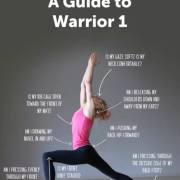How To Do Warrior 1 (Cute Infographic!)
We love this graphic guide to Warrior 1, except for how far back her head is. Gaze forward or slightly up, not up towards the ceiling. This pose is great for strengthening your hips, gluts quads, core, and arms. Such a strong pose! That’s why it’s called warrior! Read more below!
by Amy Jirsa | Featured on mindbodygreen
Whenever my students have a pose they absolutely cannot stand, it’s almost inevitably Warrior I (Virabhadrasana I). And, for a long time, that always surprised me. Finally, one day, I really tried to break it down during my practice. Then I got it.

This is a super dynamic pose. I mean, think about what’s happening in the body — every limb is involved and they’re all going in different directions.
The torso is extended so there may also be a small backbend going on here.
The shoulders are drawing together and down, and the gaze is lifted (either up or out).
Yeah. I can see the trouble.
There’s also the often-taught direction that the hips must be squared to the front of the mat — but so often, due to skeletal structure, muscle tension, and/or muscle strength, this is impossible and the effort will lead to knee pain or injury.
And if that’s all the student is focused on —squaring the hips? Well, the rest of the pose falls pretty drastically apart.
Instead, I tell my students to have a firm foundation in the feet first. Personally, I like a wider stance here because it frees up the pelvis and gives me more space for rotation.
Stack the front knee in line with the front ankle and foot, and draw in and up on the pelvic floor, which will give you some grounding and balance. Then, use that low belly muscle lock (Uddiyana Bandha) and rotate the abdomen and rib cage around to the front of the mat. This is where we’re truly looking for that rotation. Now you have a little space to breathe. Woo! Nice, right?
From here, the arms extend up (I put my palms together and gaze up because that’s traditional in my Ashtanga practice, but the arms can just extend straight up or even out if you have rotator cuff issues) while the shoulder blades draw together and down.
The gaze is focused, either up or out — whatever the neck comfortably allows. The arms are also rotating inwards. Think of rolling the triceps together or of rolling the pinky-sides of the hands toward each other. This will give you so much more space in the shoulders, allowing you to spread the collarbones.
Then? Settle in. This is a beautiful asana and will build so much strength in your body, yes, but also in your mind and in your breath. Remain mindful and feel the extension — both hands, both feet, heart, belly, and chin lifted in celebration of your practice.
For more tips on your form with poses, or to attend a yoga class led by yoga instructor and physical therapist, Chie Tadaki DPT contact our office.
